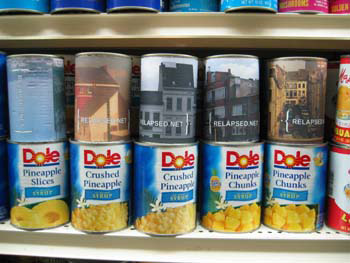Starting in 1989 with the Barbie Liberation Organisation, replacing products in warehouses and grocery stores has been in the shadow zone for a very long time. Many of the actions undertaken by guerilla-shoppers have reached the news, and are signs of a subculture that’s worth looking at. A good move from consumers to market other consumers, but bad for an existing brand, for you no longer see the brandname or characteristics consumers tend to look for whilst shopping.
What is reverse-shoplifting?
To covertly place merchandise on display in a store. Primarily used in guerrilla ad campaigns, tactical media projects, and art installations.
Is it legal ? No. You can’t replace a producer’s branded product with a custom made design of your own. Otherwise Pepsi could go ’round and start decorating Coca-Cola cans and vice-versa, in the end resulting in big confusion with the consumer. No need to say a confused shopper is very easily drawn to tempting products, so chances are that by reverse-shoplifting too many products of one brand, this brand will lose some of its precious consumers and consequently will sue the ‘artist’.
Alternative terms : shop-drop, droplift.
From the Shop-Drop Site:
Shopdropping strives to take back a share of the visual space we encounter on a daily basis. Similar to the way street art stakes a claim to public space for self expression, Shopdropping subverts commercial space and activities for artistic purposes.


More about the results of ‘Teen Talk Barbie’ and ‘Talking Duke G.I.Joe’ :
Johnson isn’t alone. The BLO’s hack has evolved, ironically, into what Howard Rheingold has only half-joking called “an underground business opportunity.” A BLO member told NPR’s Scott Simon, “Nobody wants to return [the dolls]…We think that our program of putting them back on the shelves [benefits] everyone: The storekeepers make money twice, we stimulate the economy, the consumer gets a better product and our message gets heard.” (Mark Dery in 1994)
“Calling themselves the Barbie Disinformation Organization, the group strikes not at the dolls themselves, but at the packaging that envelops and contextualizes them. They print up stickers in a style identical to traditional Mattel packaging and slap them on Barbie products on the shelves (front and back), effectively replacing Mattel’s pleas to the daddy’s little girls of the world with their own. And what tow-headed little princess wouldn’t want the “Barbie Lesbian Barber Shop” (formerly “Barbie’s Stylin’ Salon”), complete with instructions on how to give Barbie “Dyke Haircut nos 1 & 2″. And what father wouldn’t want her daughter to beam in psychotic gratitude for “Lipstick Lesbian Betty” (formerly “Barbie’s Best Friend Betty”. There’s something for the young presumably pre-date raping males as well- somehow “Secret Agent #007 — with uppercut punch action!” Becomes “Corporate Drone Dan — with Gropomatic(tm) Fanny-Patting Grip”
To put in in persepective : Imagine an artist redesigning the Google or Yahoo index and ‘hacking’ it. Would Google or Yahoo tolerate this ?
No. Because it would confuse other users. Even if it is a real work of art, there is no way it would be appreciated. Geeks would collect the print-screen and you (the artist) would be traced and prosecuted.
So, there’s your answer from the company-side of this issue.
Article by Brigitte Greenberg (AP)
Hacking Barbie’s Voice Box by Mark Dery.
Shop-Drop Website by Relapsed
Barbie Liberation Organization
[via Larz,D.]